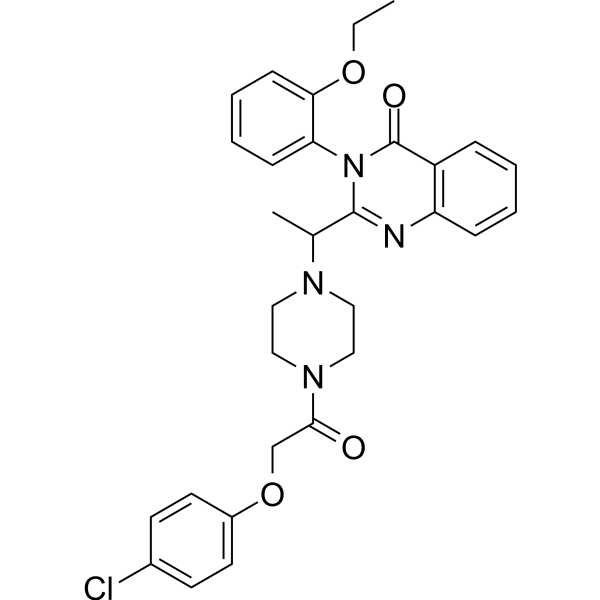Home
Products
Erastin



| Product Name | Erastin |
| Price: | Inquiry |
| Catalog No.: | CN00387 |
| CAS No.: | 571203-78-6 |
| Molecular Formula: | C30H31ClN4O4 |
| Molecular Weight: | 547.04 g/mol |
| Purity: | >=98% |
| Type of Compound: | Alkaloids |
| Physical Desc.: | Powder |
| Source: | |
| Solvent: | Chloroform, Dichloromethane, Ethyl Acetate, DMSO, Acetone, etc. |
| SMILES: | CCOc1ccccc1n1c(nc2c(c1=O)cccc2)C(N1CCN(CC1)C(=O)COc1ccc(cc1)Cl)C |
| Contact us | |
|---|---|
| First Name: | |
| Last Name: | |
| E-mail: | |
| Question: | |
| Description | Erastin is a ferroptosis activator. |
| In Vitro | Erastin triggers oxidative, iron-dependent cell death. Treatment of NRAS-mutant HT-1080 fibrosarcoma cells with the RSL molecule erastin (10 µM) results in a time-dependent increase in cytosolic and lipid ROS beginning at 2 hours[1]. Cell death triggered by erastin is significantly inhibited by antioxidants (e.g., α-tocopherol, butylated hydroxytoluene, and β-carotene) and iron chelators (e.g., deferoxamine), suggesting that ROS- and iron-dependent signaling is required for erastin-induced ferroptosis. Erastin can directly bind to VDAC2/3 in BJeLR cells. Knockdown of VDAC2 and VDAC3, but not VDAC1, leads to erastin resistance. Erastin has the ability to reduce glutathione level by directly inhibiting cystine/glutamate antiporter system Xc− activity, with activation of the ER stress response[2]. Erastin potently inhibits HT-29 cell survival. Erastin shows a dose-dependent effect, and 30 μM of erastin displays the most dramatic effect[3]. |
| In Vivo | Intraperitoneal injection of erastin at well-tolerated doses dramatically inhibits HT-29 xenograft growth in severe combined immunodeficient mice[3]. |
| Cell Assay | To test erastin’s activity on colorectal cancer cell survival, HT-29 cells are treated with increasing concentrations of erastin (0.1–30 μM). MTT assay was performed[3]. |
| Animal Admin | Mice: Mice are treated daily with 10 or 30 mg/kg body weight of erastin (intraperitoneal injection, for 4 weeks) or vehicle control (Saline). Tumor volumes are calculated. Mice body weights are also recorded every week[3]. |
| Density | 1.3±0.1 g/cm3 |
| Boiling Point | 721.9±70.0 °C at 760 mmHg |
| Flash Point | 390.4±35.7 °C |
| Exact Mass | 546.203369 |
| PSA | 76.90000 |
| LogP | 4.75 |
| Vapour Pressure | 0.0±2.3 mmHg at 25°C |
| Storage condition | −20°C |